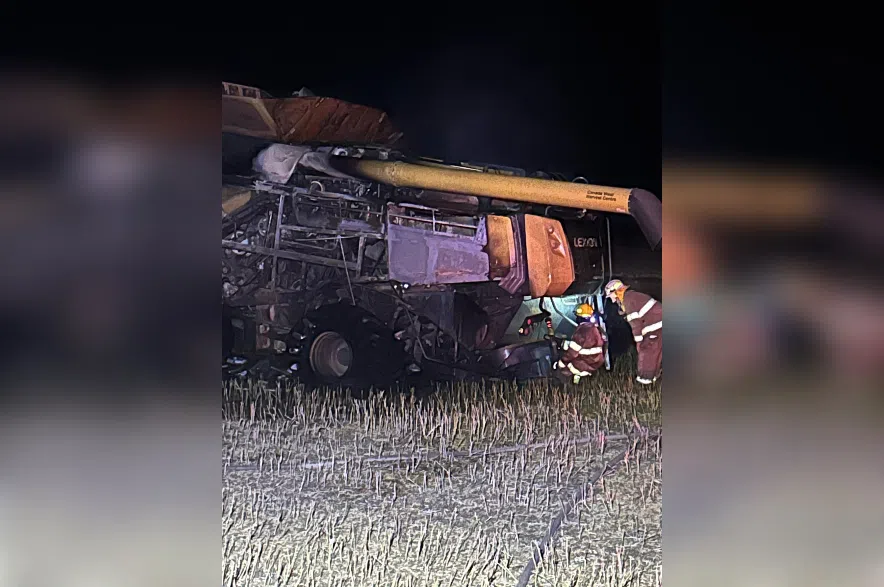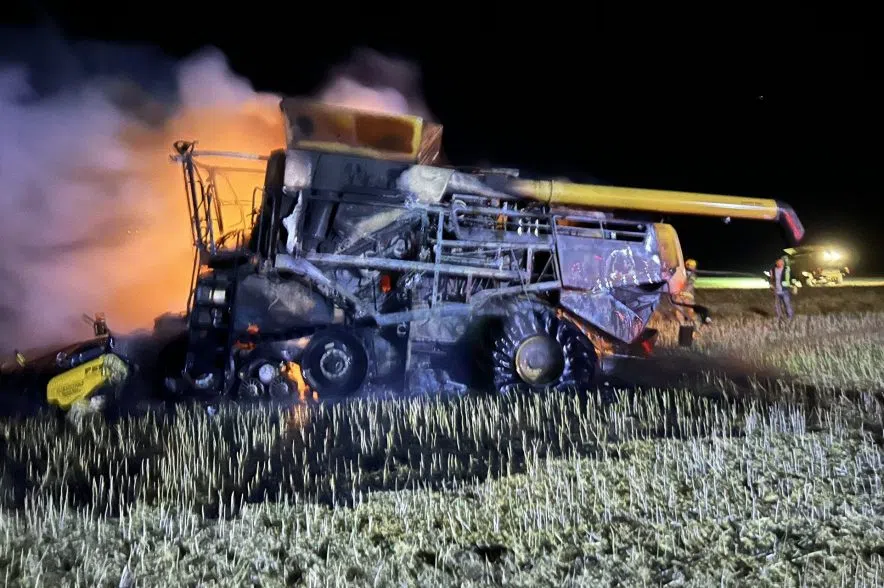With harvest coming to a close in Saskatchewan, the Ministry of Agriculture is encouraging farmers to keep fire extinguishers and water tanks nearby.
The latest crop report said there has been an increase in machinery fires reported.
Read more:
- New website delivers advanced tools and data for pulse crop producers
- Peavey Mart charts a comeback in Alberta and Saskatchewan
- Sask. adds elk hunting opportunity in effort to limit crop damage
That statement rings true for Nicholas Ferre, the fire chief of the Zenon Park and District Fire Department.
He said his unit has responded to two combine fires this harvest — more than usual.
“The first one wasn’t a total loss, it was mostly the header,” Ferre said. “Then the second one was a total loss.”

Firefighters look at a combine destroyed by flames near Zenon Park. (Zenon Park and District Fire Department/Facebook)
Working as a farmer himself, Ferre said he understands how the flames can put pressure on the producer.
“This is where we make our money, so time is of the essence,” he said. “We need to get the crop off fast, and any hiccup like this is very stressful.
“It just adds to the stress of what we deal with every day.”
Shelley Andrews, the deputy fire chief with Eagle Creek Fire Department, said its responded to one header fire this year at the end of September.
“We were just leaving the header to burn because it was already damaged, it was unsavable,” she said.
“Everybody was safe putting when they were unhooking it, but all that plastic goes up so fast what the new headers are made of.”
Andrews said the fire department has not seen a higher amount of machinery fires in the area so far this year.
The fire departments encouraged farmers to have their fire suppression equipment nearby while working.
In an email from the Ministry of Agriculture, it said it does not track the amount of machinery fires in the province.

Powdery mildew coats the engine compartment after a combining a field infected with the fungal disease. (980 CJME file photo)
Disease development causing combine fire risks, says agronomist
While there are many factors that can occur in a machinery fire, Sask Oilseeds is alerting farmers about the powdery mildew coming off their canola crops.
When canola goes through the combine, the dust from the disease can stick to the hot parts of the machine.
Kaeley Kindrachuk, an agronomy extension specialist with organization, said the mildew can plug up combines if its not swept off.
“Powdery mildew produces this dusty or powdery white fungal growth on the canola plant,” she said. “When it goes through the combine, that’s what we would see on the equipment.
“When we have a build up of that white dust, that’s what can can contribute to the combine fires.”
Kindrachuk said powdery mildew isn’t a disease that affects canola every year, but wet and foggy mornings accelerated the fungal growth.
“The environmental conditions were just perfect for that disease development this year,” she said.
Kindrachuk said the disease has also been seen in other cereal crop this year.
Ferre said he has taken notice of the dusty powder on the machines and believed it was part of problem in some machinery fires he had responded to.
He would encourage farmers to blow the dust off of their equipment regularly to keep the machines from overheating.
“I know most people blow it off once a day, but maybe increasing that to two or three times a day,” Ferre said.
Read more:
- New website delivers advanced tools and data for pulse crop producers
- Peavey Mart charts a comeback in Alberta and Saskatchewan
- Sask. adds elk hunting opportunity in effort to limit crop damage











